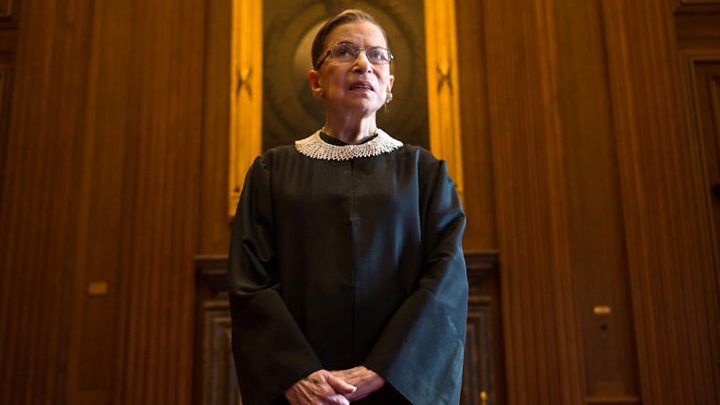Trump to name Supreme Court nominee ‘by week’s end’

US President Donald Trump has said he will name his nominee for Supreme Court justice by the end of the week, and urged the Republican-controlled Senate to confirm his choice before the presidential election.
The plan has launched a high-stakes battle ahead of the 3 November vote.
Mr Trump wants to replace Ruth Bader Ginsburg, a liberal stalwart who died on Friday aged 87, with a conservative.
He appears to have secured enough support in the Senate.
This would cement a right-leaning majority on the US’s highest court, where justices serve for life or until they choose to retire.
The ideological balance of the nine-member court is crucial to its rulings on the most important issues in US law, with decisions made in recent years on immigration, carbon emissions and gay marriage.
Democrats have criticised Mr Trump’s plan, with presidential candidate Joe Biden dubbing it an “abuse of power”.
Meanwhile, Ms Ginsburg is set to become the first woman in history to lie in state in the US Capitol building later this week. Following her death from cancer, people around the country have been paying tribute to the prominent feminist, who served on the court for 27 years.
What happens next with the nomination?
On Monday, Mr Trump said he was “constitutionally obligated” to nominate someone for the Supreme Court.
“We’re looking at five incredible jurists… women that are extraordinary in every way. I mean, honestly, it could be anyone of them, and we’re going to be announcing it on Friday or Saturday,” he told supporters at a rally in Ohio.
- US voters’ verdict on Supreme Court vacancy
- Ruth Bader Ginsburg’s death sparks political firestorm
- Meet the Supremes – the judges on the top US court
The president earlier had a private meeting at the White House with potential nominee Amy Coney Barrett, an appeals court judge who is backed by anti-abortion conservatives.
Once the president names a nominee, it is the Senate’s job to vote on whether to confirm them. The Judiciary Committee will review the pick first, and then vote to send the nominee to the floor for a full vote.
Senate majority leader Mitch McConnell has vowed to hold a confirmation vote before the election in November. Democrats have accused him of hypocrisy.
Following the death of conservative justice Antonin Scalia in 2016, Mr McConnell refused to hold a vote to confirm a nominee put forward by then-President Barack Obama, a Democrat.
Image copyright Getty Images
Mr Obama had nominated Merrick Garland in February of that year – months before the election – but Mr McConnell argued that Supreme Court justices should not be approved in an election year.
However, this time around, with a president of the same party, the Senate leader says because the Senate and White House are both Republican-held, unlike 2016, the nomination should proceed.
Do Senate Republicans have the votes?
Supreme Court nominees used to need 60 votes in the Senate to be approved. But in 2017, Mr McConnell held a vote to change the rules, so that nominees would need a simple majority of 51 votes in the 100-seat Senate. This enabled Senate Republicans to push through confirmation of Mr Trump’s nominee Neil Gorsuch.
Republicans currently hold a 53-47 majority in the upper chamber.
The president’s plan to appoint a justice was boosted on Monday after two closely watched senators of his party, Cory Gardner of Colorado and Charles Grassley of Iowa, signalled they backed moving ahead.
Their support may grant Republicans the 50 votes they need to confirm a justice, given that Vice-President Mike Pence can cast a tie-breaking vote if needed.
Lindsey Graham, the powerful Republican chairman of the Senate Judiciary committee, said on Monday he would be “leading the charge to make sure that President Trump’s nominee has a hearing, [and] goes to the floor of the United States Senate for a vote”.
Mitt Romney, of Utah, remains undecided. Susan Collins of Maine and Lisa Murkowski of Alaska, have backed a delay in the vote.
Ms Collins said she had “no objection” to the process of reviewing a candidate beginning now, but that she did not believe the Senate should vote on the candidate before November’s election. Ms Collins is facing a tough re-election bid this year.
Ms Murkowski said she “did not support taking up a nomination eight months before the 2016 election” and believed the “same standard must apply” now.
Even if Republicans lose their Senate majority on 3 November, the new Congress does not take office until 3 January, which would give the existing senators time to confirm Mr Trump’s pick.
If the nominee is not confirmed by 20 January, Inauguration Day, they would have to be re-nominated by the president (whoever that ends up being).
Battle over Supreme Court
Image copyright Getty Images
- What is the US Supreme Court?
- Why US top court is more political than UK’s
- The big issues Trump’s Supreme Court handled
- Who are top contenders to fill the seat?
How long does it take to confirm a Supreme Court judge?
Typically, it’s a months long process to go from selection to confirmation – but there are no rules regarding this time frame.
Since 1975, it has taken about 70 days on average. This time, the election is just weeks away.
The last time lawmakers completed a confirmation this speedily was for Ginsburg’s own selection in 1993. She was approved in 42 days.
What’s at stake?
The highest court in the US is often the final word on highly contentious laws, disputes between states and the federal government, and final appeals to stay executions.
In recent years, the court has expanded gay marriage to all 50 states, upheld President Trump’s travel ban on several predominantly Muslim countries, and delayed a US plan to cut carbon emissions while appeals went forward.
The court also handles reproductive rights issues like abortion – a highly contentious election issue, especially for one of Mr Trump’s key Republican constituencies. Opponents of abortion have called for overturning abortion protections, and appointing judges who sympathise with this view is one of Mr Trump’s pitches for re-election.

Clara Spera, Ginsburg’s granddaughter, disclosed that the late justice’s dying wish was not to be replaced until after the election. “She was concerned about this country and about the court that she served so diligently for over 27 years,” Ms Spera told BBC World Service.
“I think that she would be heartened to know that there are many, many people who believe that we need to return to order and norms, and agree and want to fulfil that most fervent wish of hers,” she said.
Ginsburg will lie in state at the US Capitol on Friday.
What’s the reaction?
Speaker of the House Nancy Pelosi, the most powerful Democrat in Washington, suggested she may try to influence what happens next with the confirmation.
Mrs Pelosi told the New York Times she had “arrows in [her] quiver, in the House quiver” but would not offer more details.
On Sunday, Democratic presidential candidate Joe Biden said Mr Trump had “made clear this is about power, pure and simple”.
He urged Senate Republicans to “please follow your conscience, let the people speak, [and] cool the flames that have been engulfing our country”.
Image copyright Reuters
During a vigil for Ginsburg on Sunday night, Democratic Senator Elizabeth Warren drew cheers from the crowd for criticising Republicans over the nomination.
“Mitch McConnell and his henchmen believe that they can ram through a Supreme Court justice only 45 days from Election Day,” she said. “What Mitch McConnell does not understand is that this fight has just begun.”
Who are seen as top contenders?
- Amy Coney Barrett: Member of the Chicago-based 7th Circuit Court of Appeals, she is a favourite of religious conservatives and known for her anti-abortion views. She was a legal scholar at Notre Dame Law School in Indiana
- Barbara Lagoa: A Cuban American of the Atlanta-based 11th Circuit Court of Appeals, she was the first Hispanic judge on the Florida Supreme Court. She is a former federal prosecutor
- Kate Comerford Todd: Deputy White House Counsel, has a lot of support inside the White House. Served as former senior VP and Chief Counsel, US Chamber Litigation Center





